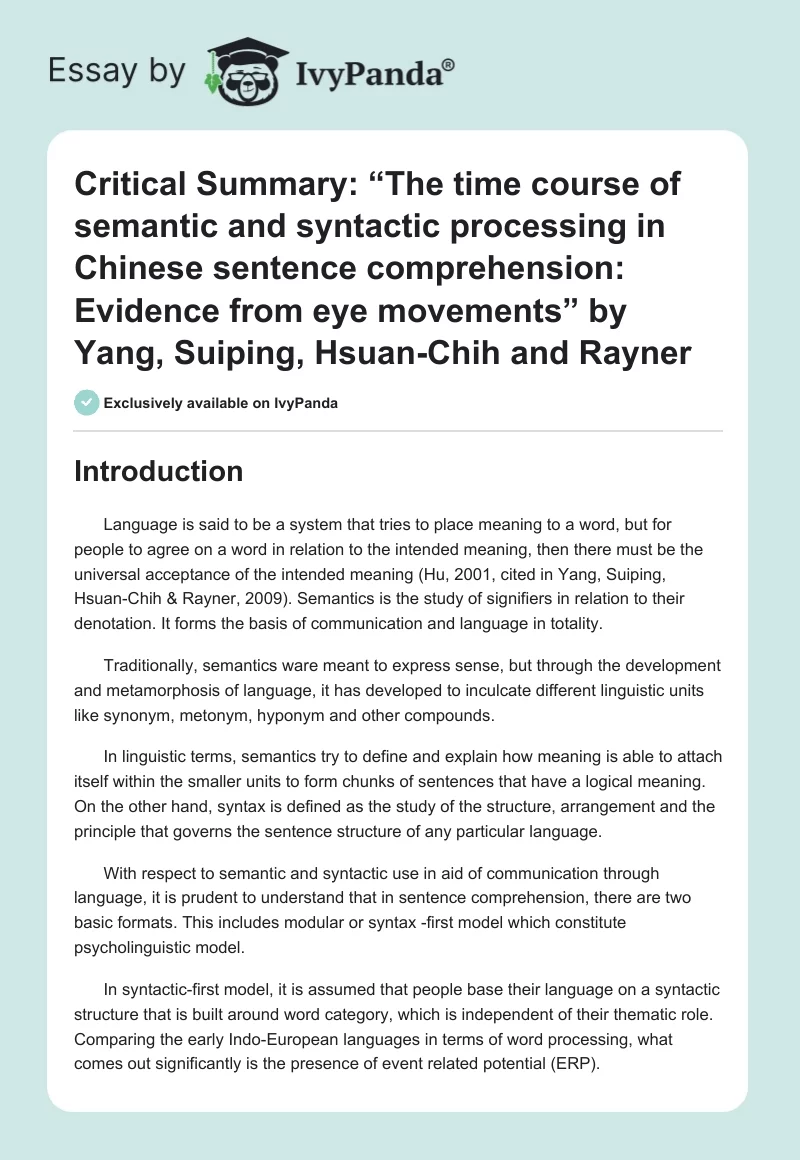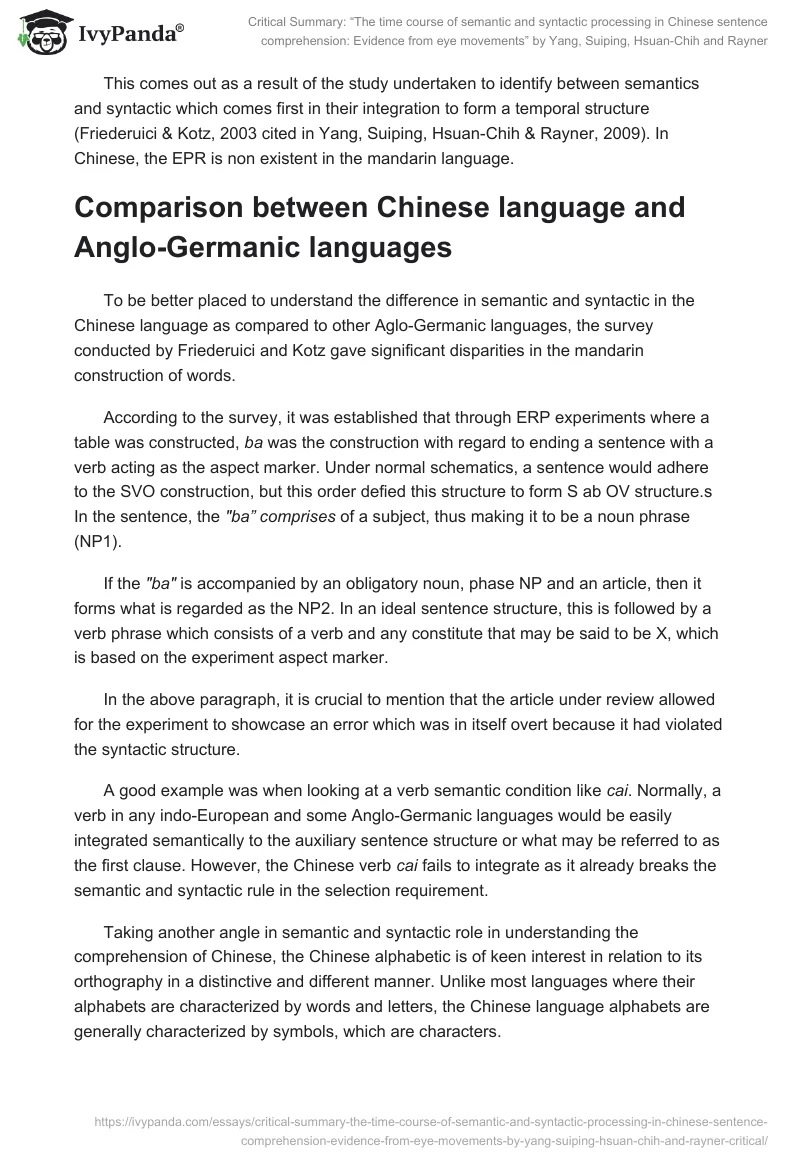Introduction
Language is said to be a system that tries to place meaning to a word, but for people to agree on a word in relation to the intended meaning, then there must be the universal acceptance of the intended meaning (Hu, 2001, cited in Yang, Suiping, Hsuan-Chih & Rayner, 2009). Semantics is the study of signifiers in relation to their denotation. It forms the basis of communication and language in totality.
Traditionally, semantics ware meant to express sense, but through the development and metamorphosis of language, it has developed to inculcate different linguistic units like synonym, metonym, hyponym and other compounds.
In linguistic terms, semantics try to define and explain how meaning is able to attach itself within the smaller units to form chunks of sentences that have a logical meaning. On the other hand, syntax is defined as the study of the structure, arrangement and the principle that governs the sentence structure of any particular language.
With respect to semantic and syntactic use in aid of communication through language, it is prudent to understand that in sentence comprehension, there are two basic formats. This includes modular or syntax -first model which constitute psycholinguistic model.
In syntactic-first model, it is assumed that people base their language on a syntactic structure that is built around word category, which is independent of their thematic role. Comparing the early Indo-European languages in terms of word processing, what comes out significantly is the presence of event related potential (ERP).
This comes out as a result of the study undertaken to identify between semantics and syntactic which comes first in their integration to form a temporal structure (Friederuici & Kotz, 2003 cited in Yang, Suiping, Hsuan-Chih & Rayner, 2009). In Chinese, the EPR is non existent in the mandarin language.
Comparison between Chinese language and Anglo-Germanic languages
To be better placed to understand the difference in semantic and syntactic in the Chinese language as compared to other Aglo-Germanic languages, the survey conducted by Friederuici and Kotz gave significant disparities in the mandarin construction of words.
According to the survey, it was established that through ERP experiments where a table was constructed, ba was the construction with regard to ending a sentence with a verb acting as the aspect marker. Under normal schematics, a sentence would adhere to the SVO construction, but this order defied this structure to form S ab OV structure.s In the sentence, the “ba” comprises of a subject, thus making it to be a noun phrase (NP1).
If the “ba” is accompanied by an obligatory noun, phase NP and an article, then it forms what is regarded as the NP2. In an ideal sentence structure, this is followed by a verb phrase which consists of a verb and any constitute that may be said to be X, which is based on the experiment aspect marker.
In the above paragraph, it is crucial to mention that the article under review allowed for the experiment to showcase an error which was in itself overt because it had violated the syntactic structure.
A good example was when looking at a verb semantic condition like cai. Normally, a verb in any indo-European and some Anglo-Germanic languages would be easily integrated semantically to the auxiliary sentence structure or what may be referred to as the first clause. However, the Chinese verb cai fails to integrate as it already breaks the semantic and syntactic rule in the selection requirement.
Taking another angle in semantic and syntactic role in understanding the comprehension of Chinese, the Chinese alphabetic is of keen interest in relation to its orthography in a distinctive and different manner. Unlike most languages where their alphabets are characterized by words and letters, the Chinese language alphabets are generally characterized by symbols, which are characters.
Thus, in the Chinese language an alphabet may have either a single character or multiple characters. In the case of an alphabet having more than one character, then it is considered a morpheme. This means that the intended meaning of a word in a sentence in Chinese is not precise, and thus open for interpretation based on the context.
Earlier on, in the discussion based on the EPR experiment, it was realized that the Chinese language in terms of verbs structure lacks inflectional markers or indicators. The effect of this is that in a Chinese sentence, it is difficult to tell whether the verb matter is in the present or past tense.
Also, for a sentence to be complete, there must be a subject-verb agreement to give it congruency, but since the Chinese language lacks the inflectional markers, then for a reader to be able to comprehend the meaning of a word, then he/she has to rely on morphological aspects or cues.
The above findings have brought about a lot of debate on the ability of comprehending the Chinese language, both oral and written, with some scholars arguing that since meaning in the Chinese language is not precise as explained above, comprehension of the Chinese language cannot be immediate as in other languages. Therefore, a slower model should be adopted while reading to reduce the ambiguity of the words in the context.
These scholars have gone further to say that the Chinese language in regard to relative timing lacks a well-defined semantic and syntactic process through which readers can be able to understand the idea of syntactic properties unlike English readers who basically have the idea (Aaronson & Ferres, 1986, cited in Yang, Suiping, Hsuan-Chih & Rayner, 2009).
The other school of thought argues that the Chinese language has its own syntactic rules that are independent of the semantic, but unlike other languages are flexible.
Effects of syntactic and semantic positioning
In recent studies on syntactic and semantic in relation to the Chinese language, researchers have diversified their focus to applying the violation paradigm to understand the comprehension process of the Chinese language (Chen 1999, cited in Yang, Suiping, Hsuan-Chih & Rayner, 2009). According to Chen, understanding Chinese will always be difficult as syntactic violation will always be a hindrance to semantic processing.
The violation paradigm was later revised to come up with a new standard referred to as pure syntactic violation (Ye, Luo, Friederici, & Zhou, 2006; Yu& Zhang, 2008, cited in Yang, Suiping, Hsuan-Chih & Rayner, 2009). The essence of these new standards was arrived at through the elimination from a noun phrase, a noun object.
This altered the structure of a propositional-object phrase from Chen model. As a result of this attraction, the new model comes up with four sets of sentences that were correct, incorrect, semantically incorrect, or syntactically incorrect. In terms of timing and position, the study came up with findings that suggested that between syntactic and semantic processes, syntactic appeared earlier.
Although this study shed a lot of light into the study of semantic and syntactic role in the comprehension of the Chinese language, there are demerits to it, especially in regard to the syntactically incorrect sentence. For instance, in the sentence, the study had omitted a noun from the prepositional object-phrase structure which resulted to semantic disruption.
There are a lot of effects in semantic and syntactic violation. These effects are as a result of the use of the ERP technique that in itself gives a high resolution in terms of temporal details.
However, it is worth noting that although the ERP technique can reveal a lot of information in regard to the brain activities with relation to semantic and syntactic manipulation, it offers very little information about brain activity in terms of information uptake (comprehension) of written language.
This has resulted to analyst raising two questions. First, is it possible for syntactic and semantic processing to occur concurrently? Secondly, can syntactic and semantics processes be separated while reading online? At the present time, no clear-cut answers can be given in regard to the two questions.
Conclusion
In conclusion, it is worth noting that the various violations mentioned in this paper in regard to Chinese in terms of eye movement can only be placed squarely as being attributed by syntactic processing rather than the divergent degree of semantic violation.
In this sense, if the violation effect is as a result of SEM+SYN, then the effects are bound to appear in different positions of the sentence. In case the effect is as a result of SEM+SYN, the effect may be characterized by it appearing either prior to or after the position.
Reference
Yang, J., Suiping, W., Hsuan-Chih, C., Rayner, K., (2009). The time course of semantic and syntactic processing in Chinese sentence comprehension: Evidence from eye movements. Memory and Cognition. 37 (8), Pp.1-13


